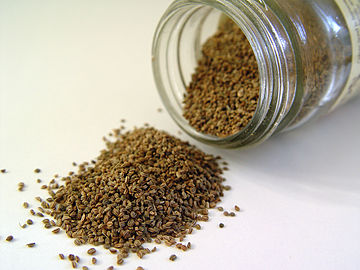Celery/ja: Difference between revisions
Created page with "セロリは植民地時代のアメリカの庭園ではあまり目立たず、その料理上の限界は、『A Treatise on Gardening, by a Citizen of Virginia』の著者による「パセリの一種」という観察に反映されている。印刷物での最初の詳細な扱いは、バーナード・マクマホンの『American Gardener's Calendar』(1806年)であった。" |
No edit summary |
||
| (2 intermediate revisions by the same user not shown) | |||
| Line 31: | Line 31: | ||
セロリの香りと味の主な原因となる化学物質は、[[butylphthalide/ja|ブチルフタリド]]と[[sedanolide/ja|セダノリド]]である。 | セロリの香りと味の主な原因となる化学物質は、[[butylphthalide/ja|ブチルフタリド]]と[[sedanolide/ja|セダノリド]]である。 | ||
==語源{{ | ==語源{{Anchor|Etymology}}== | ||
[[Wikipedia:John Evelyn|John Evelyn]]によって1664年に「sellery」として英語で初めて記録され印刷された、現代英語の「celery」は、[[:en:French language|フランス語]]の''céleri''に由来し、これはさらに[[:en:Italian language|イタリア語]]の''seleri''(''selero''の複数形)から来ており、''selero''は[[:en:Late Latin|後期ラテン語]]の''selinon''、すなわち{{langx|grc|σέλινον|selinon}}(「セロリ」)の[[:en:Latinisation (literature)|ラテン語化]]である。この単語の最も古い証明された形式は、[[:en:Linear B|線文字B]]音節文字で書かれた[[:en:Mycenaean Greek|ミケーネ・ギリシャ語]]の''se-ri-no''である。 | [[Wikipedia:John Evelyn|John Evelyn]]によって1664年に「sellery」として英語で初めて記録され印刷された、現代英語の「celery」は、[[:en:French language|フランス語]]の''céleri''に由来し、これはさらに[[:en:Italian language|イタリア語]]の''seleri''(''selero''の複数形)から来ており、''selero''は[[:en:Late Latin|後期ラテン語]]の''selinon''、すなわち{{langx|grc|σέλινον|selinon}}(「セロリ」)の[[:en:Latinisation (literature)|ラテン語化]]である。この単語の最も古い証明された形式は、[[:en:Linear B|線文字B]]音節文字で書かれた[[:en:Mycenaean Greek|ミケーネ・ギリシャ語]]の''se-ri-no''である。 | ||
| Line 144: | Line 144: | ||
セロリは植民地時代のアメリカの庭園ではあまり目立たず、その料理上の限界は、『A Treatise on Gardening, by a Citizen of Virginia』の著者による「[[parsley/ja|パセリ]]の一種」という観察に反映されている。印刷物での最初の詳細な扱いは、[[:en:Bernard M'Mahon|バーナード・マクマホン]]の『American Gardener's Calendar』(1806年)であった。 | セロリは植民地時代のアメリカの庭園ではあまり目立たず、その料理上の限界は、『A Treatise on Gardening, by a Citizen of Virginia』の著者による「[[parsley/ja|パセリ]]の一種」という観察に反映されている。印刷物での最初の詳細な扱いは、[[:en:Bernard M'Mahon|バーナード・マクマホン]]の『American Gardener's Calendar』(1806年)であった。 | ||
19世紀半ば以降、洗練されたサクサクとした食感と味を求めて選抜が続けられ、セロリはアメリカの食卓に登場し、[[:en:celery vase|セロリの花瓶]]に入れられて塩を振って生で食べられた。セロリは19世紀から20世紀初頭にかけて米国で非常に人気があり、[[:en:New York Public Library|ニューヨーク公共図書館]]の[http://menus.nypl.org/ 歴史的メニューアーカイブ]によると、当時ニューヨーク市のメニューで[[coffee/ja|コーヒー]]と[[tea/ja|紅茶]]に次いで3番目に人気のある料理であった。当時、セロリは栽培が困難であったため、[[caviar/ja|キャビア]]よりも高価であった。また、当時は栽培が難しく、輸送にも適さないため、現在では存在しない多くの種類のセロリがあった。 | |||
古代ギリシャでは[[:en:Chthonic|地下]]の象徴であったセロリは、[[:en:Samothrace|サモトラケ]]、[[:en:Lemnos|レムノス]]、[[:en:Thebes, Greece|テーベ]]で崇拝された地下の神々である[[:en:Cabeiri|カベイロイ]]の父、[[:en:Cabeiri|カドミロス]]の血から生じたと言われている。そのスパイシーな香りと濃い葉の色は、この死の崇拝との関連性を助長した。古典ギリシャでは、セロリの葉は死者のための花輪として使われ、[[:en:Isthmian Games|イストミア競技会]]の勝者の花輪は当初セロリで作られていたが、後に[[pine/ja|松]]で作られた冠に置き換えられた。[[:en:Pliny the Elder|プリニウス]]によると、[[:en:Achaea (Roman province)|アカイア]]では、神聖な[[:en:Nemean Games|ネメア競技会]]の勝者が身につける花輪もセロリで作られていた。[[:en:Sicily|シチリア島]]にある古代ギリシャの植民地[[:en:Selinunte|セリヌス]]({{langx|grc|Σελινοῦς}}、''Selinous'')は、そこに豊富に自生していた野生のパセリにちなんで名付けられた。セリヌスのコインには、都市の象徴としてパセリの葉が描かれていた。 | |||
==関連項目== | ==関連項目== | ||
Latest revision as of 13:17, 17 June 2025
| セロリ | |
|---|---|
 販売のためのセロリ | |
| Genus | Apium |
| Species | Apium graveolens |
| Cultivar group | Dulce Group |
セロリ(Apium graveolens Dulce Group または Apium graveolens var. dulce')は、セリ科のセロリ種に属する栽培植物で、古くから野菜として利用されてきた。
もともとの野生種は、何世紀にもわたる品種改良により、主に3つの栽培品種群に分かれた。繊維質の食用の茎を目的とする茎セロリ(Dulce Group)、香りの良い葉を目的とする葉セロリ(Secalinum Group)、そして大きく食用の胚軸を目的とする根セロリ(Rapaceum Group)である。セロリは、その長く筋の入った茎、羽状の葉、そして散形花序に配置された小さな白い花が特徴である。
セロリは主に水分(95%)で構成されていますが、ビタミンKを豊富に含み、脂肪はごくわずかである。この野菜は一般的にサラダで生食されたり、スープやシチューで調理されたり、ジュースにされたりする。強い香りのあるセロリシードは、スパイスとして使われたり、セロリソルトに加工されたりする。セロリは、アレルギー反応を引き起こす可能性のある少数の食品の一つである。
歴史的に、セロリは薬用、料理、象徴的な意味を持っていた。文献資料には古代ギリシャでのセロリ栽培の証拠があり、古代エジプト人は葬儀用の花輪に組み込んでいた。セロリは世界中で食べられ続けている。
特徴
セロリの葉は羽状から二回羽状で、菱形の小葉は長さ3–6 cm、幅2–4 cmである。花はクリームがかった白色で、直径2–3 mmであり、密な複合散形花序に咲く。種子は広卵形から球形で、長さ1.5–2 mm、幅1.5–2 mmである。現代の栽培品種は、充実した葉柄または大きな胚軸のいずれかのために選抜されてきた。セロリの茎は「筋」に容易に分離するが、これは維管束の外側にある角張った厚角細胞の束である。
化学
セロリの香りと味の主な原因となる化学物質は、ブチルフタリドとセダノリドである。
語源
John Evelynによって1664年に「sellery」として英語で初めて記録され印刷された、現代英語の「celery」は、フランス語のcéleriに由来し、これはさらにイタリア語のseleri(seleroの複数形)から来ており、seleroは後期ラテン語のselinon、すなわちAncient Greek: σέλινον, romanized: selinon(「セロリ」)のラテン語化である。この単語の最も古い証明された形式は、線文字B音節文字で書かれたミケーネ・ギリシャ語のse-ri-noである。
分類
Apium graveolens種はカール・フォン・リンネによって1753年の彼の著書『植物の種』第1巻で記述された。栽培セロリはApium graveolens var. dulceまたはApium graveolens Dulce Groupと呼ばれてきた。
栽培
植物は種子から育てられ、季節に応じて温床または露地庭に蒔かれ、1、2回の間引きと移植の後、高さ15–20 cmに達すると、軟白のために深い溝に植え付けられる。軟白は茎から光を遮断するために土を盛ることによって行われる。土盛りを必要としないセロリの自生軟白品種の開発は、商業市場とアマチュア市場の両方を支配している。
セロリは当初、冬から早春の野菜として栽培された。塩漬け肉を中心とした新鮮な野菜のない冬の食事による欠乏症を補うための、浄化作用のある強壮剤と考えられていた。19世紀までに、イングランドにおけるセロリの旬は9月上旬から4月下旬まで延長された。
北米では、セロリの商業生産は「パスカル」セロリと呼ばれる品種が主流である。庭師は様々な品種を栽培でき、その多くは野生種とは異なり、主に茎が太い。これらは白と赤の2つの分類に分けられる。茎は密でまっすぐに平行に束になり成長し、通常はそのように新鮮な状態で販売される。根は取り除かれ、少量の緑の葉だけが残されて販売される。
茎は生で、またはサラダの材料として、あるいはスープ、シチュー、鍋焼きの風味付けとして食べることができる。
収穫と保管
収穫は畑のセロリの平均サイズが市場に出せる大きさになったときに行われる。作物の生育が非常に均一なため、畑は一度しか収穫されない。葉柄と葉が取り除かれ、収穫される。セロリはサイズと品質(色、形、葉柄のまっすぐさや厚さ、茎と中肋の長さ、病気、ひび割れ、裂け目、虫害、腐敗の有無によって決定される)によって梱包される。商業的な収穫では、セロリは36〜48本の茎を含み、最大27 kgの重さのカートンに梱包される。最適な条件下では、セロリは0〜2℃で最大7週間保存できる。0℃を超える温度で保管すると、内側の茎は成長を続ける可能性がある。貯蔵寿命は、曇り止め加工された微細穿孔のシュリンクラップにセロリを梱包することで延長できる。セロリの新鮮に切断された葉柄は腐敗しやすいが、これは加工中の鋭利な刃の使用、丁寧な取り扱い、適切な衛生管理によって防止または減少させることができる。
セロリの茎は、まず葉を取り除き、次に茎を水で茹でてから、最後に酢、塩、植物油を加えることでピクルスとして保存することができる。
亜硫酸塩
かつて、レストランではセロリを粉末の野菜保存料を入れた水の容器に保存していたが、その保存料に含まれる亜硫酸塩が一部の人々にアレルギー反応を引き起こすことが判明した。1986年、米国食品医薬品局は、生食を目的とした果物や野菜への亜硫酸塩の使用を禁止した。
アレルギー反応
セロリはアレルギー反応を引き起こす可能性のある少数の食品グループの1つであり、セロリのアレルギーを持つ人々にとっては、曝露によって潜在的に致命的なアナフィラキシーショックを引き起こす可能性がある。花粉に敏感な個人において、セロリの根の摂取によるアレルギー反応の事例も報告されており、胃腸障害やその他の症状を引き起こすが、ほとんどの場合、セロリ過敏症は臨床的に重要とは見なされていない。欧州連合および英国では、微量であってもセロリを含む、または含む可能性のある食品は明確に表示されなければならない。
Apium graveolens植物はOPALSアレルギー尺度で10段階中4の評価を受けており、アレルギー反応を引き起こす中程度の可能性を示しており、庭全体で同じ植物を過剰に使用すると悪化する。セロリは皮膚の発疹や、ニンジンやブタクサとの交差反応を引き起こしている。
| 100 g (3.5 oz)あたりの栄養価 | |||||||||||||||||||||||||||||||||||||||||||||||||||||||||||
|---|---|---|---|---|---|---|---|---|---|---|---|---|---|---|---|---|---|---|---|---|---|---|---|---|---|---|---|---|---|---|---|---|---|---|---|---|---|---|---|---|---|---|---|---|---|---|---|---|---|---|---|---|---|---|---|---|---|---|---|
| エネルギー | 57 kJ (14 kcal) | ||||||||||||||||||||||||||||||||||||||||||||||||||||||||||
2.97 g (食物繊維を含む) | |||||||||||||||||||||||||||||||||||||||||||||||||||||||||||
| 澱粉 | 0.00 g | ||||||||||||||||||||||||||||||||||||||||||||||||||||||||||
| 砂糖 | 1.34 g | ||||||||||||||||||||||||||||||||||||||||||||||||||||||||||
| 食物繊維 | 1.6 g | ||||||||||||||||||||||||||||||||||||||||||||||||||||||||||
0.17 g | |||||||||||||||||||||||||||||||||||||||||||||||||||||||||||
| 飽和 | 0.042 g | ||||||||||||||||||||||||||||||||||||||||||||||||||||||||||
| 一価不飽和 | 0.032 g | ||||||||||||||||||||||||||||||||||||||||||||||||||||||||||
| 多価不飽和 | 0.079 g | ||||||||||||||||||||||||||||||||||||||||||||||||||||||||||
0.69 g | |||||||||||||||||||||||||||||||||||||||||||||||||||||||||||
| |||||||||||||||||||||||||||||||||||||||||||||||||||||||||||
| その他の成分 | 量 | ||||||||||||||||||||||||||||||||||||||||||||||||||||||||||
| 水 | 95.43 g | ||||||||||||||||||||||||||||||||||||||||||||||||||||||||||
| †割合は、カリウムを除き、成人に対する米国 推奨値を使用して推定された。カリウムは、全米科学・工学・医学アカデミーの専門家による推奨に基づき推定された。 | |||||||||||||||||||||||||||||||||||||||||||||||||||||||||||
使用法
栄養
生のセロリは、95%が水分、3%が炭水化物、0.7%がタンパク質であり、脂肪はごく少量である。100gの摂取量で14カロリーの食物エネルギーを提供し、1日摂取量の24%を供給するビタミンKの豊富な供給源であるが、その他の微量栄養素は有意な量ではない。
料理
セロリは世界中で野菜として食されている。北米やヨーロッパでは、パリパリとした葉柄(葉の茎)が使われる。ヨーロッパでは、胚軸も根菜として使われる。葉は風味が強く、スープやシチューの風味付け、または乾燥ハーブとして使われることは少ない。セロリ、タマネギ、ピーマンは、ルイジアナ・クレオール料理やケイジャン料理の「聖なる三位一体」である。セロリ、タマネギ、ニンジンは、ソースやスープのベースによく使われるフランスのミルポワを構成する。セロリは多くのスープの主材料である。イランのシチューkhoresh karafsにも使われている。
葉
セロリの葉は、料理によく使われ、黒コショウに似ているがよりマイルドな、ほんのりスパイシーな風味を加える。セロリの葉は乾燥させて焼いた魚、揚げた魚、またはローストした魚や肉に振りかけたり、スープやシチューに使うのに適した新鮮な調味料のブレンドの一部として適している。また、生でサラダに混ぜたり、飾り付けとして食べることもできる。
種子

温帯地域では、セロリは種子のためにも栽培される。実際には非常に小さな果実であり、これらの「種子」は香水産業で使われる貴重な精油を産出する。この油には化学化合物のアピオールが含まれている。セロリの種子は、そのままの種子または粉砕して、風味付けや香辛料として使用できる。
セロリソルト
セロリの種子を粉砕して塩と混ぜると、セロリソルトができる。セロリソルトは根からの抽出物から、または乾燥葉を用いて作ることができる。セロリソルトは調味料として、カクテル(一般的にはブラッディ・メアリーカクテルの風味を高めるため)、シカゴ風ホットドッグ、およびオールドベイシーズニングに使われる。同様に、セロリパウダーと塩の組み合わせは、工業的な発色剤の代替として、熟成豚肉や他の加工肉の風味付けと保存に使われる。セロリに自然に含まれる硝酸塩は、添加された塩と相乗的に作用して食品を熟成させる。
セロリジュース
2019年、米国でブログに投稿された「解毒」の主張に基づき、セロリジュースを飲むトレンドが報告された。これらの主張には科学的根拠がないが、このトレンドはセロリの価格を大幅に高騰させた。
文化において


ダニエル・ゾハリーとマリア・ホプフは、ツタンカーメン王(紀元前1323年没)の墓で発見された花輪の中にセロリの葉と花序が含まれていたこと、また紀元前7世紀にまで遡るセロリの分果がサモス島のヘライオンで発見されたことを特筆している。しかし、彼らは「A. graveolensがこれらの地域に自生しているため、これらの遺物が野生種なのか栽培種なのかを判断するのは難しい」と指摘している。セロリが栽培されたのは古典古代になってからだと考えられている。
M. フラギスカは、紀元前9世紀にまで遡るセロリの考古学的発見をカスタナスで言及しているが、古代ギリシャに関する文献的証拠ははるかに豊富である。ホメロスの『イーリアス』では、ミュルミドン族の馬がトロイの湿地に生える野生のセロリを食べているとあり、『オデュッセイア』では、カリュプソの洞窟を取り囲むスミレと野生のセロリの牧草地について言及されている。
シャルルマーニュの『カピトゥラリ』(西暦約800年編纂)には、フランク王が栽培を望んだ薬草や野菜の中にapiumが、またolisatum、すなわちアレクサンダーズが登場する。中世ヨーロッパのどこかの時点で、セロリはアレクサンダーズに取って代わった。
「セロリ」という名称は、ヨーロッパ料理における植物の時代とともに次々とを辿っている。英語の「celery」(1664年)は、ロンバード語のseleriに由来するフランス語のcéleriから来ており、これはさらにギリシャ語から借用されたラテン語のselinonに由来する。
セロリがイギリスの食卓に遅れて登場したのは、樹液の苦味を減らし糖分を増やすために必要な種子選抜の長い伝統の最終結果である。1699年までに、ジョン・イヴリンは彼の著書『Acetaria. A Discourse of Sallets』の中でセロリを推奨することができた。「セロリ、apium Italicum、(そしてパセリ科の植物)はかつて我々にとっては見知らぬものであった(イタリアでもそれほど昔のことではないが)。これはマケドニアパセリまたはスモールエイジの一種であり、より熱く、より高貴な種類である…そしてその高い評価される風味のために、常に我々の偉大な人々の食卓やプラエトルの宴会の「グランドサラダ」の中央に置かれ、食卓全体の品位を保っている。」
セロリは植民地時代のアメリカの庭園ではあまり目立たず、その料理上の限界は、『A Treatise on Gardening, by a Citizen of Virginia』の著者による「パセリの一種」という観察に反映されている。印刷物での最初の詳細な扱いは、バーナード・マクマホンの『American Gardener's Calendar』(1806年)であった。
19世紀半ば以降、洗練されたサクサクとした食感と味を求めて選抜が続けられ、セロリはアメリカの食卓に登場し、セロリの花瓶に入れられて塩を振って生で食べられた。セロリは19世紀から20世紀初頭にかけて米国で非常に人気があり、ニューヨーク公共図書館の歴史的メニューアーカイブによると、当時ニューヨーク市のメニューでコーヒーと紅茶に次いで3番目に人気のある料理であった。当時、セロリは栽培が困難であったため、キャビアよりも高価であった。また、当時は栽培が難しく、輸送にも適さないため、現在では存在しない多くの種類のセロリがあった。
古代ギリシャでは地下の象徴であったセロリは、サモトラケ、レムノス、テーベで崇拝された地下の神々であるカベイロイの父、カドミロスの血から生じたと言われている。そのスパイシーな香りと濃い葉の色は、この死の崇拝との関連性を助長した。古典ギリシャでは、セロリの葉は死者のための花輪として使われ、イストミア競技会の勝者の花輪は当初セロリで作られていたが、後に松で作られた冠に置き換えられた。プリニウスによると、アカイアでは、神聖なネメア競技会の勝者が身につける花輪もセロリで作られていた。シチリア島にある古代ギリシャの植民地セリヌス(Ancient Greek: Σελινοῦς、Selinous)は、そこに豊富に自生していた野生のパセリにちなんで名付けられた。セリヌスのコインには、都市の象徴としてパセリの葉が描かれていた。
関連項目
- Apium virus Y/ja
- Celery mosaic virus/ja
- Celery powder/ja
- Celery vase/ja
- Liriomyza trifolii/ja – セロリハモグリバエ
- Vallisneria americana/ja – ワイルドセロリ
- List of vegetables/ja
外部リンク
- Apium graveolens in Plant Resources of Tropical Africa (PROTA)
- Quality standards, from the USDA website
| この記事は、クリエイティブ・コモンズ・表示・継承ライセンス3.0のもとで公表されたウィキペディアの項目Celery(24 May 2025, at 15:13編集記事参照)を翻訳して二次利用しています。 |


